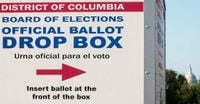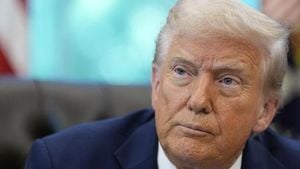President Donald Trump’s long-standing crusade against mail-in voting took another dramatic turn this week, as the White House abruptly shifted its strategy from issuing an executive order to seeking legislative changes. The move, announced just one day after Trump doubled down on his vow to “get rid of MAIL-IN BALLOTS,” has sparked a fresh round of debate across the political spectrum, raising questions about the fate of absentee voting, the integrity of U.S. elections, and the potential impact on military voters stationed overseas.
It all began early Monday morning, August 18, 2025, when Trump posted on social media at 7:17 a.m., promising to lead a movement not only to eliminate mail-in ballots but also to target what he called “Highly ‘Inaccurate,’ Very Expensive, and Seriously Controversial VOTING MACHINES.” According to Roll Call, Trump asserted that these machines cost ten times more than “accurate and sophisticated Watermark Paper,” which he claimed would deliver faster, more reliable election results. Later that same day, speaking to reporters in the Oval Office, Trump announced, “We’re going to start with an executive order that’s being written right now by the best lawyers in the country to end mail-in ballots because they’re corrupt.”
But just over 24 hours later, the White House’s tone had changed. Press secretary Karoline Leavitt signaled that the administration would pivot away from the executive order, instead pursuing legislative solutions. “The White House continues to work on this, and when Congress comes back to Washington I’m sure there will be many discussions with our friends on Capitol Hill, and also our friends in state legislatures across the country, to ensure that we’re protecting the integrity of the vote for the American people,” Leavitt said on August 19. She added, “I think Republicans generally and the president generally wants to make it easier for Americans to vote and harder for people to cheat in our elections.”
When pressed about the rapid change in approach and whether Trump had been advised that such a sweeping executive order might be beyond his authority, the White House deflected. Principal deputy press secretary Harrison Fields instead accused Democrats of undermining confidence in elections. “Democrats have eroded faith in our elections with reckless laws, such as unfettered mail-in voting, illegally changing laws to benefit their voters, and slow-walking the counting of votes far past Election Day,” Fields said in an email. He maintained, “President Trump wants to secure America’s elections and protect the vote, restoring the integrity of our elections by requiring voter ID, ensuring no illegal ballots are cast, and preventing cheating through lax and incompetent voting laws in states like California and New York.”
Despite the White House’s tough rhetoric, Trump’s claims have repeatedly been challenged by independent reviews and international comparisons. For instance, Trump insisted on social media, “We are now the only Country in the World that uses Mail-In Voting. All others gave it up because of the MASSIVE VOTER FRAUD ENCOUNTERED.” However, data from the International Institute for Democracy and Electoral Assistance, cited by Roll Call, show that 33 countries—including the United States, Canada, Germany, Iceland, New Zealand, Poland, and the United Kingdom—allow some form of mail-in voting. Another 21 countries, from Australia to France to India, permit mail-in voting for certain groups.
Trump’s assertion that the federal government administers U.S. elections was also quickly debunked. In reality, state and local governments oversee elections, a fact that even White House officials did not dispute when questioned. Yet, the president’s repeated claims have fueled partisan tensions and stoked debate over the future of voting rights in America.
One group watching these developments with particular concern is the U.S. military community. On August 20, White House officials clarified that, despite Trump’s hardline stance, he remains committed to ensuring that overseas and out-of-state military ballots will still be counted in upcoming elections. This assurance is crucial: in the 2024 election cycle alone, more than 980,000 active-duty troops, family members, and U.S. citizens living abroad cast ballots through the mail, according to Military Times.
Still, the details of how military voters will be protected remain murky. The Uniformed and Overseas Citizens Absentee Voting Act requires states to transmit absentee ballots to eligible voters—including military personnel and their families—no later than 45 days before a federal election, giving them time to vote and return their ballots. These voters already must provide proof of citizenship and eligibility. Yet, as Military Times reported, the administration has pushed for further restrictions, and in April 2025, military advocates joined a lawsuit challenging the constitutionality of an executive order that would have ended ballot counting after Election Day for votes delayed in the mail and required extra documentation for absentee voters.
Asked about the administration’s current stance, Harrison Fields reiterated the president’s goal: “Trump aims to secure elections by requiring voter ID, preventing illegal ballots, and addressing lax voting laws.” Pentagon officials, however, have so far stayed silent on how proposed changes might affect service members’ ability to vote from afar.
The broader political context is equally contentious. Trump’s renewed push comes after he told Fox News commentator Sean Hannity on August 15 that Russian President Vladimir Putin had raised concerns about America’s mail-in voting during a summit on the Ukraine conflict in Alaska. That revelation drew swift condemnation from Senate Rules and Administration Committee ranking member Alex Padilla, who said Trump was “now taking advice on voter suppression from a murderous dictator who rigs elections, jails political opponents, and persecutes dissent.” Padilla didn’t mince words: “Trump knows the MAGA agenda is unpopular: raising your grocery prices and hiking up your health care premiums, all while handing out tax breaks to billionaires. So he’s resorting to desperate schemes to cling to power.” He called on Congress to “stand up for free and fair elections as he continues his assault on our democracy.”
Data from the 2024 election cycle underscore why mail-in voting has become such a flashpoint. Of the 65.7 million mail ballots requested, 44 percent came from registered Democrats, 29 percent from Republicans, and 27 percent from other voters, according to an analysis by TargetSmart for NBC News. With Democrats enjoying a clear advantage in mail-in balloting, it’s little wonder that the issue has become so politically charged.
Adding to the uncertainty, Trump has sent mixed signals about his own political future. In an August 5 interview with CNBC, he said he would “probably not” run for a third term, only to quickly add, “I’d like to run. I have the best poll numbers I’ve ever had.” Such ambiguity has left both supporters and critics guessing about his next moves, even as he continues to challenge the fundamentals of the U.S. voting system.
As Congress prepares to reconvene and the 2026 midterm elections loom on the horizon, the battle over mail-in voting is far from over. The stakes are high—not just for partisan advantage, but for the millions of Americans, including military families, whose ability to participate in democracy may hang in the balance. The coming months will reveal whether legislative compromise is possible, or whether the fight over how America votes will only intensify.




